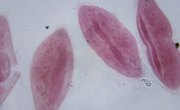
Eagles and E. coli. Salamanders and salmonella. Meadow sage and methanococcales. Organisms vary a lot on the outside, in large part because their interiors -- cells -- are so different. Eukaryotes are distinguished from other organisms primarily because their cells have nuclei. In fact, their name refers to that: “eukaryote” is Greek for “true nut.” Some eukaryotes are so common you see them every day. Some are more rare, while others require a microscope to view.
They Are Everywhere
The largest of category eukaryotes is the animal kingdom. Animals are made up of complex cells, have tissue and organ systems and use sexual reproduction. More than 1 million species fall into this biological kingdom, including birds, fish, reptiles, amphibians, insects, worms, mollusks, jellyfish and sponges. Clearly, a wide range of organisms fits into this category. You, your dog, your goldfish, whales, rattlesnakes, frogs, spiders, earthworms and snails are all examples of eukaryotes.
It's Not Easy Being Green
Eukaryotes include all members of the plant kingdom. Like animals, plants have many cells. Unlike animals, most plants undergo photosynthesis. During this process, plants use the sun’s light to make energy for themselves. They are different from animals because their cells have walls that help keep their parts rigid. In addition, plants have no nervous systems. Different types of plants tend to grow well in specific locations, and they vary in size tremendously. Examples include the desert-dwelling cactus, forest ferns and sagebrush from the grasslands, as well as tiny baby’s breath and giant redwood trees.
Fungi Fun
Fungi may resemble plants, but they are a different kingdom of eukaryotes. The main difference is that fungi do not undergo photosynthesis. Most get their nutrition from decomposed plant matter. Like plants and animals, the majority of fungi have many multi-part cells. Although some fungi are used to produce helpful drugs such as antibiotics, others cause illnesses like athlete's foot and ringworm. Certain fungi are edible, and a few are used to make bread and beer. Mushrooms, mold, yeast and mildew are kinds of fungi.
All the Rest
The kingdom Protista contains a large variety of small eukaryotes. Some consist of single cells, others live in colonies and still others are composed of many cells. No matter their appearance, they all need a water source for their home. This can take many forms: freshwater, seawater, snow, moist soil and even animal hair. Some protists use photosynthesis to meet their energy needs. Members of this kingdom include various types of amoeba, green, red and brown algae, tiny euglena and slime molds.
References
About the Author
Living in upstate New York, Susan Sherwood is a researcher who has been writing within educational settings for more than 10 years. She has co-authored papers for Horizons Research, Inc. and the Capital Region Science Education Partnership. Sherwood has a Ph.D. in curriculum and instruction from the University at Albany.
Photo Credits
Goodshoot/Goodshoot/Getty Images
